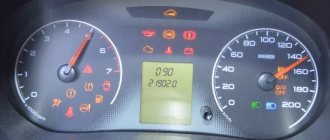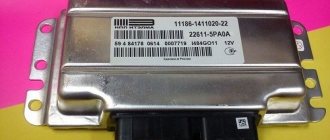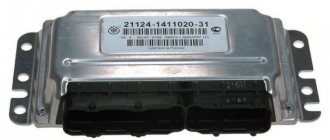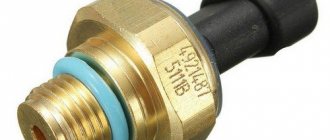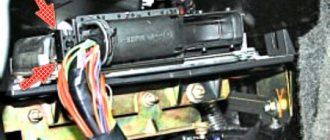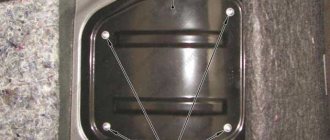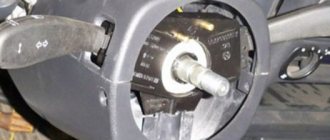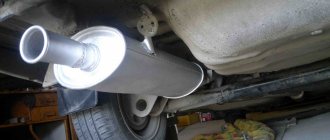Various sensors are responsible for the operation of all systems of a modern car. They take readings and transmit them to the electronic engine control unit (ECU). If the sensor malfunctions, an error is stored in the memory, and in some cases a Check Engine error appears on the instrument panel.
Where are the sensors located?
All modern Lada cars (Granta, Kalina, Priora, Vesta, Largus, Niva or Lada XRAY) are equipped with domestic VAZ engines. The location of the sensors on these motors is the same:
Elements of the electronic engine control system of the VAZ 11186/11189: 1* – controller; 2* – crankshaft position sensor; 3* – control oxygen concentration sensor; 4* – diagnostic block; 5* – diagnostic oxygen concentration sensor; 6 – throttle control unit; 7* – vehicle speed sensor; 8* – adsorber purge valve; 9* – gas pedal module; 10* – brake signal switch; 11* – clutch pedal position sensor; 12 – battery; 13 – mass air flow sensor; 14 – coolant temperature sensor; 15 – ignition coil; 16 – knock sensor; 17 – spark plugs; 18* – nozzles. *The item is not visible in the photo.
Location of ECM elements in the vehicle interior (for clarity, without dashboard): 1 – clutch pedal position sensor; 2 – brake signal switch; 3 – gas pedal module; 4 – controller.
Coolant temperature sensor (DTOZH)
Designed to measure coolant temperature in the engine cooling system. Based on the indicators, the ECU adjusts the crankshaft speed, the composition of the fuel-air mixture and the ignition timing. The sensor practically does not break, but sometimes it lies. Quite often the wires at the base of the connector fray so much that there is nothing to even solder to. The coolant temperature sensor is installed in the thermostat cover.
See Replacing and checking DTOZH.
Knock sensor (DS)
Designed to determine the moment of occurrence of high-frequency vibrations of the cylinder block that occur during detonation combustion of fuel. Based on the sensor signal, the electronic engine control unit selects the optimal ignition timing, which allows for the most complete and efficient combustion of the fuel-air mixture in the engine cylinders, as well as automatically adjusting the ignition timing for fuels with different octane numbers. The knock sensor is located on the front wall of the cylinder block between the 2nd and 3rd cylinders.
See “Replacing and Inspecting the Knock Sensor.”
Smart choice
The Lada Kalina 8 valve has certain differences from the 16 valve engine. However, automotive specialists sometimes install a mechanism with 8 valves to 16, and the engine works correctly.
The main differences between similar system elements:
- form;
- connector size.
The Kalina 8 cl phase sensor may be distinguished by the absence of a special slot required for the signal disk. This product cannot be installed on an engine with sixteen valves. It operates with a pin mounted on the camshaft (at the very end).
To avoid situations of inconsistency, purchase a mechanism according to the characteristics of the engine. No need to pay attention to the manufacturer's markings. The spare part number according to the VAZ catalog (Granta, Largus, Kalina, Priora) will always be the same:
- engine with eight valves - 21110370604000;
- 16-valve – 21120370604000.
Definition of failure
The device is located close to the cylinder head, on the power unit. It is easy to understand the first signs of poor functioning of the mechanism, especially for an experienced car enthusiast.
Here are the main criteria for recognizing a breakdown:
- a light comes on and goes out, designed to constantly monitor the engine while turning the ignition key in the car;
- “Check engine” lights up on the dashboard after the starter makes three to four revolutions and the engine comes into action. The sensor will be triggered if the electronic control unit does not receive the necessary information and has to use data from the DPKV;
- engine dynamics become worse - the vehicle slowly picks up speed (this is easy to notice when driving downhill). In this case, there are three reasons for the problem. The first - the camshaft sensor is broken, the second - the mass air flow sensor is broken, the third - the compression is reduced;
- high fuel consumption - this “symptom” is not very accurate and has a number of possible causes. You shouldn’t take it as a separate criterion for a problem, but you can use it as one of several.
If the mechanism fails, the “Check engine” will light up, and the system will display error “P0340”. Such a moment means a 100% malfunction. If this happens, you need to check the device. After a detailed diagnosis, it is recommended to replace the faulty parts.
Crankshaft position sensor (CPS)
The sensor provides the control unit with information about the speed and angular position of the crankshaft. Based on the sensor signals, the ECU calculates the phase and duration of the control pulses for the injectors and ignition coil. If it malfunctions (no signal), the engine will not start. It is located in the tide hole of the oil pump cover.
See Replacing and checking DPKV.
Ignition module (IZ)
The ignition module consists of two ignition coils placed in a housing and filled with dielectric resin. Each of the coils is responsible for supplying a spark to two cylinders. The MH rarely fails completely, as one of the coils is damaged and, consequently, two cylinders fail at once.
Signs of malfunction:
- The engine is twin;
- Loss of dynamics;
- Increased fuel consumption;
Camshaft position sensor (phase sensor)
Designed to generate a signal by which the ECU determines the top dead center of the piston of the first cylinder during the compression stroke. The operating principle of the sensor is based on the Hall effect. If the sensor is faulty, the ECU switches the system to backup mode. The engine may run erratically, stall, or have difficulty starting. DPRV cannot be repaired. If it malfunctions, it is replaced with a new one.
See “Replacing and checking the phase sensor (PPRV) on LADA”.
DBP and DTV
The absolute pressure sensor (MAP) and the air temperature sensor (ATS) are used on VAZ 21129 and VAZ 21179 engines. They are combined in one housing, which is installed on the receiver of the intake module. They are described in more detail here.
Idle air control (IAC)
The IAC is installed on the throttle body. Structurally, it is similar to a DC motor with a worm gear. At the tip of the sensor there is a cone head that closes or opens the idle passage in the throttle, thereby regulating the air supply to the engine at idle. This sensor is installed only on a mechanical throttle and is involved in operation only at idle.
Signs of malfunction:
- The engine stalls at idle;
- The revolutions are floating;
- When starting, you must press on the gas pedal;
Oxygen sensor (OS) or lambda probe
The oxygen concentration sensor allows you to estimate the amount of remaining unburned fuel or oxygen in the exhaust gases. The signal is used by the control unit to maintain the optimal ratio of air to gasoline in the combustion chamber. Installed in the catalytic collector before the exhaust gas catalytic converter.
Refer to Oxygen Sensor Replacement and Testing.
Mass air flow sensor (MAF)
This important sensor is located behind the engine air filter. It is also called an air flow meter. Its purpose is to estimate the amount of air entering the car engine. Based on the information received from the sensor, the electronic control unit (ECU) calculates the required amount of fuel to maintain the stoichiometric fuel-to-air ratio for the given engine operating conditions.
See “How to check the mass air flow sensor on LADA cars”
Replacing the device
Installing a new device is actually quite simple. To do this you will need a minimal set of tools and very little time:
- disconnect the battery;
- compress the spring clamp of the device;
- remove the cable block from the sensor;
- unscrew the fastening screws;
- remove the sensor, install a new one and do all the same manipulations in reverse order.
This is how the rough road sensor is changed on most domestic cars; on foreign cars this process may look a little different.
Vehicle speed sensor (VS)
Serves to measure vehicle speed and transmit this information to the ECU. Its failure is directly related to a non-functioning speedometer. The vehicle speed sensor is installed on top of the clutch housing, above the right front wheel drive inner joint housing. Replacing it is very simple.
Method number 1. Visual control
The factory software has settings that provide for a running-in mode for the power plant and its further operation under average conditions. A malfunction of the mass air flow sensor, as noted above, leads to either an over-enrichment or a depletion of the fuel mixture with gasoline or diesel fuel, which negatively affects the functioning of the engine and can lead to serious damage.
Intake system channel length control valve
AVTOVAZ began installing an intake manifold with variable geometry starting with the VAZ-21127 engine. This design allows for maximum torque at low speeds and maximum power at high speeds. The length of the intake manifold is adjusted (switching from one length to another) using a valve that is part of the engine management system.
See how to replace and test the sensor.
Diagnostic process
Instrument panel with which you can perform diagnostics
So, diagnostic operations using the dashboard are not complicated and almost every Kalina car owner is able to cope with this on their own. Following the step-by-step instructions described below, you can carry out diagnostics on any generation of VAZ 1117-1119.
Clutch and brake sensors
Based on the signals from the clutch pedal position sensor and the brake light switch, the controller distinguishes between pressed and unpressed pedal positions. When the clutch pedal is pressed, the controller disables engine load regulation. Both sensors are located on the pedal assembly.
See "Replacing and Inspecting the Clutch Pedal Sensor" and "Replacing and Inspecting the Brake Pedal Sensor."
Some vehicle versions use an electronic throttle valve drive (E-gas). Let us remind you that in order to understand what errors are recorded in the ECU, you need to decipher them.
Keywords: Lada Granta sensors | Lada Kalina sensors | Lada Priora sensors | Lada Granta engine | Lada Kalina engine | Lada Priora engine | Lada Vesta sensors | Lada Largus sensors | 4x4 sensors | lada xray sensors | lada xray engine | Lada Vesta engine | Lada Largus engine | 4x4 engine | ECM Lada Vesta | ECM Lada XRAY | ECM Lada Largus | ECM Lada Granta | ECM Lada Kalina | ECM Lada Priora | ECM 4x4 | Niva sensors | Niva engine | esud niva | universal article
2 0 0 0 0 0
Share on social networks:
